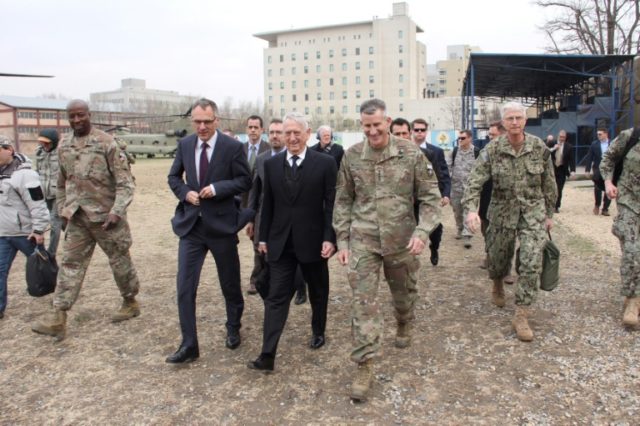The Trump administration has determined that after nearly a trillion dollars spent and thousands of Americans killed and injured in the Afghanistan war, “reconciliation” between Kabul and Taliban terrorists presents the best way to end the nearly 17-year-old conflict, a top U.S. general said Wednesday.
Gen. John Nicholson, the top commander of American and NATO troops in Afghanistan, told Pentagon reporters that the primary goal of U.S. President Donald Trump’s Afghan war strategy is reconciliation.
“The goal of the South Asia strategy is reconciliation. … The end state of the policy is to achieve a reconciliation,” Nicholson declared.
U.S. President Trump unveiled his South Asia plan in August of last year. The strategy aims to pressure the Taliban to engage in peace negotiations.
Gen. Nicholson suggested that the Trump strategy had established the conditions for the Taliban and the Afghan government to reach a peace agreement, telling reporters:
Within six months of President Trump’s announcement and the implementation of the strategy, we had the elements of a peace proposal outlined by the Taliban in an open letter to America and a formal peace offer by [Afghan] President [Ashraf] Ghani.
…
There is a robust [peace] dialogue going on inside the Taliban…there’s tremendous potential to advance the reconciliation dialogue.
Nicholson noted that “confidential” peace talks are taking place at various levels between the different stakeholders.
The commander revealed:
I think what you’re seeing right now is a lot of the diplomatic activity and dialogue is occurring off the stage, and it’s occurring at multiple levels. So you see mid-level, senior-level Taliban leaders engaging with Afghans.
…
We see outreach from Taliban fighters who are tired of fighting, who are concerned about the effect of this continued fighting on their country.
We’ve seen some public calls by Taliban leaders. For example, a Taliban judge in Northern Afghanistan called on the Taliban leadership to accept President Ghani’s peace offer.
Soon after the Taliban penned a letter urging the American people to convince Trump to end the war, Ghani offered the terrorist group a ceasefire and official recognition as a political organization.
The U.S.-NATO coalition backed Ghani’s proposal.
Gen. Nicholson said:
You have international governments; international organizations; external nations; internal Afghan leaders, both in and out of government; all of whom are engaged in — to varying degrees of dialogue with either those who work with the Taliban or actually some of the Taliban leaders themselves.
Nicholson stressed that, while violent conditions have deteriorated further in the wake of the Taliban’s spring offensive, peace talks have picked up steam behind closed doors, telling reporters:
Concurrent with this intensified dialogue, we saw the levels of violence drop to lower levels…We have seen the violence increase, but still to a level that is 10 percent to 12 percent below the five-year average, I call this talking and fighting.
And, as the [U.S. secretary of defense] has said, violence and progress can coexist, and that’s what we’re seeing.
The general argued that there is an unprecedented appetite for peace in Afghanistan, highlighting efforts by an independent grassroots movement in Afghanistan that is pushing for reconciliation.
Nicholson said:
This movement is nationwide. It’s grassroots. It’s not aligned with the government or anyone. It is calling on all parties to enter into ceasefires and peace talks. They have held events in over 20 provinces…this has never happened before in Afghanistan, to my knowledge, over 20 provinces.
The U.S. has devoted nearly a trillion dollars, including more than $126 billion on nation-building efforts alone, to the war in Afghanistan, which started in October 2001.
Terrorists, primarily the Taliban, have also killed at least 2,264 U.S. service-members and wounded more than 20,318.
Now, about 17 years after it removed the Taliban regime from power, the U.S. is offering the terrorist group peace and political power, pushing for reconciliation as a means to end the most protracted war in American history.
U.S. Defense Secretary Jim Mattis has defined victory in Afghanistan as “political reconciliation” between the Taliban and Kabul.
“We do look toward a victory in Afghanistan,” Mattis declared adding, “Not a military victory — the victory will be a political reconciliation” with the Taliban.”
The Taliban maintains its long-time held pre-condition for peace negotiations — the withdrawal of U.S.-NATO troops from Afghanistan, a position that mirrors that of the war-weary American people.

COMMENTS
Please let us know if you're having issues with commenting.